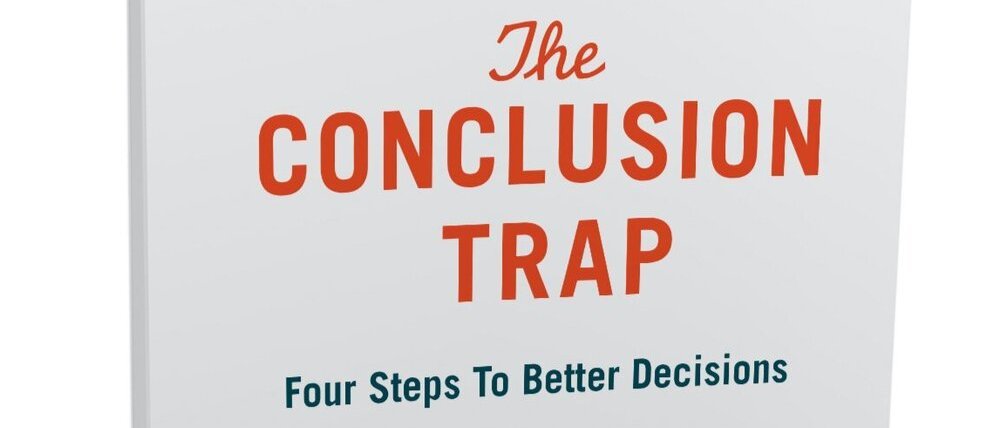Book review of 'The Conclusion Trap' by Dan Markovitz
Posted on 25th August 2022 at 11:01
A Book Review By Granger Forson
We are all Conclusion Jumpers, that is we are biologically programmed to look for patterns and make a choice. This comes from our biological survival mode from our ancient past “it that a Sabre-toothed tiger in the grass there?”. We have been survival animals for millions of generations but only be Business Owners / Leaders for a relatively few generations.
What that has manifested into is jumping to conclusions rather than understanding what is going on. As we are the leaders, we feel we
must give an answer now. Dan defines it as “ Wrong decisions are Okay. Wrong decisions are the price of doing business, of being human. What’s not okay are rash decisions based on insufficient effort to understand the real problem”.
Classic signs of not understanding problems are seen in businesses that tend to reach for 3 solutions time and again. They are:
1) Shiny new technology
2) Reorganisation
3) Money
Dan asks us to stop Being Jumpers and start to become Analysts. We are jumpers when we react to the first thing we think of, rather than understanding what is really happening.
He states” The second of the Buddha's fourth noble truths, states that the root of suffering is attachment. Everything in the world is transient, so it's wise not to get attached to anything or the way anything currently is.”
The Buddha wasn't talking about us jumping to conclusions, but the wisdom holds: don't be attached to your initial conclusions. Suspend judgement for a few moments and give yourself the time to think more deeply about the situation in front of you. This will give the analyst in us all the time needed to think. “ However we are too busy to do this, I hear you all say. This quote will help, often attributed to Einstein, “if I had an hour to solve a problem, I'll spend 55 minutes thinking about the problem and 5 minutes thinking about solutions”.
Also the 3 business solutions we normally jump to above, are the easy way out. Real problem solving for the Analyst in us does take time, but will save significantly more time and money in the future. Often the real problem requires us to look in the mirror. Sometimes the root cause of the problem is you. It's easy to blame others like: suppliers, customers, employees, equipment, regulators etc. Looking in the mirror isn't always easy. It's time to slow down to speed up and realise it starts with us.
So the tools to help us do this are well-known, easy to understand, and easy to implement. They are:
1) Go & See
2) Frame it
3) Think Backwards
4) Five why’s
1) Go & see
The father of Lean thinking, Taiichi Ohno would say “never render judgement simply on the basis of hearing about something”. He always insisted on going to the place in the question and having a look yourself. Data of course is important, but you must place the greatest emphasis on the facts. Gathering facts comes from close observation of the people ,the process, the spaces and the objects where it is actually happening. Always start from the point of view that the process is what fails not the person. It is the leadership team that has designed the process. Time to look in the mirror.
2) Frame it
How you describe the problem you're seeing will truly help you understand what is going on and not jump to conclusions. The truth is, in any business around the world, there is never enough time, money or people. Have you every heard a business leader say the opposite? You should never use these as a stating point. So a well defined or framed problem statement will open up the avenues for discussion and options. A badly defined or framed problem statement closes down alternatives and quickly send you into the cul-de-sac of single solution thinking.
Dan gives two examples:
1) Our sales team needs more admin support.
2) Our sales team spends six hours per week on low value admin tasks. The first leaves us to the conclusion that we need more people. The second leads to the conclusion that we need to be creative in how we help the admin team succeed. The golden rule is to begin with the observable facts, not opinions or judgements or interpretations to help you define / frame the problem statement.
3) Think backwards
As we are trying to avoid the tendency to leap to conclusions it's now helpful to have a tool that spurs the
analyst in us to think backwards rather than forwards. Here is where the fishbone/Ishikawa diagram comes in.
The fishbone diagram starts from the problem on the right and works backwards to the left. Under categories like:
Equipment; Process; People; Measurement; External and Internal Environments, we ask what is potentially going wrong to create the problem. We how have a list which we can use to gather more facts to find the real cause(s) of the problem. Remember, this is a tool to make us think about what is going on so we can find real facts and data rather than it is a straight jacket that we have to fill-in one way only.
4) Five Whys
The most powerful tool in our arsenal to stop us jumping inclusions is asking Why repeatedly. As we peel back the layers of the onion which is the problem in front of us, we will get down to the root cause. When we apply solutions to the root cause we will eliminate the problem in the first place.
When we have an understanding of the root cause we can now apply our creative thinking to find ways to eliminate it completely. Time and time again when we do this 5 why thinking we find that we significantly spend less money, and waste less time which is the real benefit of not jumping to conclusions.
Conclusion
From Matthew May's book 'The Elegant Solution’: ‘what appears to be the problem, isn't. What appears to be the solution, isn’t.’
As human beings, we have a built in tendency to jump to conclusions. We are seduced by what is easy. Our environment doesn't help. It's hard to resist the sirens song and the rewards of speed over thoughtfulness. This combination leads us to misunderstand the problem we face, and inevitably lead to solutions that don't solve anything. If you follow the 4 steps and become the Analyst, just imagine (as Dan puts it) “imagine not having to solve the same problem over and over again. Imagine a work life with less regret and frustration. Just for a moment imagine going home without complaining about yet another colossal waste of time, effort, money, at work. Doesn't that sound good? That future isn't far off”
Share this post:








